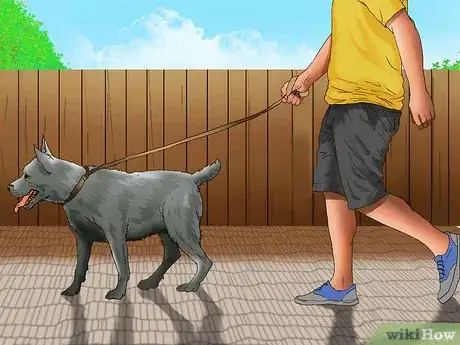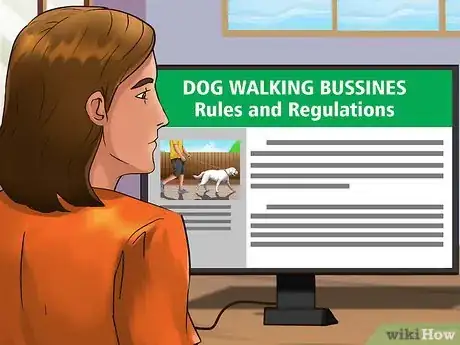This article was co-authored by Ryan Corrigan, LVT, VTS-EVN. Ryan Corrigan is a Licensed Veterinary Technician in California. She received her Bachelor of Science in Veterinary Technology from Purdue University in 2010. She is also a Member of the Academy of Equine Veterinary Nursing Technicians since 2011.
There are 7 references cited in this article, which can be found at the bottom of the page.
wikiHow marks an article as reader-approved once it receives enough positive feedback. In this case, 90% of readers who voted found the article helpful, earning it our reader-approved status.
This article has been viewed 113,768 times.
Walking dogs is considered a fun activity by many, so the idea of getting paid to do it seems too good to be true. You may be excited to start a business that’s so much fun, but keep in mind that like all businesses, a dog walking service will require some hard work. Gain the necessary knowledge and experience, tackle the business side of things, and then spread the word to effectively start your dog walking service.
Steps
Gaining Knowledge and Experience
-
1Learn about dogs. Read books and articles online about different dog breeds so that you can understand and properly handle the behavioral tendencies of each one. It is also necessary and beneficial to have knowledge about socialization techniques for dogs as well as how to read canine body posture in order to have the most success.[1]
- Greyhounds, for example, are known for their mild, sweet temperament while Siberian Huskies can be very challenging and independent due to their high level of intelligence.[2]
- Learn about the different exercise requirements for different breeds. Herding and working breeds, for example, will need longer and more frequent exercise, as will puppies. Older and very young dogs will need to go out more because they can’t control their bladders as well.
-
2Know your limits and set boundaries. Expose yourself to multiple breeds to discover if there are any that you aren’t comfortable around. Also consider trying out related services such as dog sitting, grooming, and feeding. Use what you learn from these experiences to decide which breeds and services to include in or exclude from your business.[3]Advertisement
-
3Volunteer at a local kennel or rescue shelter. As a professional dog walker, you’ll be expected to have excellent interpersonal communication skills, be active and fit, and also be extremely comfortable with walking all types of dogs. Volunteer to walk dogs being temporarily kept at a kennel, boarding facility, or rescue shelter so that over time, practice will make perfect.[4]
-
4Discover the best times and places to walk. Change up where you walk a friend’s dog or your own dog. Get to know your area better so that you can figure out the best locations and times to run your business.
- Search on the Internet for new and exciting places to take the dogs, like a puppy pool, an open agility course, or a trail in the woods. These places will interest and stimulate the dogs, something you can use to advertise your business.
- If you live in a city, for example, consider driving the dogs a couple miles away from downtown where there is more nature and fewer people.
- If you live somewhere hot, such as Arizona, you may need to adjust your hours in the summertime for the safety of the dogs.[5]
-
5Take safety precautions. As you walk your own dog or a friend’s dog, do your best to prepare for and prevent dangerous situations. When another walker walks by with a dog, place yourself between the two dogs so that they don’t get too close. Carry a can of citronella spray whenever you’re walking a dog so that you can deter any aggressive dogs or even wild animals that suddenly approach the dog you’re walking.
- If the dog you’re walking has aggressive tendencies with other dogs, avoid taking the dog to a dog park.[6]
Tackling the Business Aspects
-
1Decide what you would like your business name to be. You can either go the simple, straightforward route and create a name like “Sally’s Dog Walking” or go with something cute and catchy, like “Sir Barks-A-Lot Dog Walking.” If you think you may want to expand in the future to add on other pet care services, don't end your business name in "dog walking".
- For an open-ended model, you can describe your business as “Pet Care,” “Pet Sitting and Services,” or as a “Pet Companion.”
-
2Decide on services and rates. Make final decisions about what services you’d like to include in your business, and also come up with prices for each service so you can give prospective customers straightforward, consistent information.
- On average, dog walkers charge somewhere between $15 and $30 an hour. For the sake of getting your business going, it’s a good idea to start with low prices and move up as you acquire customers.[7]
- Research other dog walkers in your area to come up with fair, competitive prices.
-
3Choose a business entity. There are many different ways that you can run your dog business. It might be your natural instinct to run it as a sole proprietor, but also consider choosing a different kind of organization, such as a limited liability company (LLC) or a corporation. These may be a little more expensive, but they’ll offer you much more protection.
- If you make your business a corporation or LLC, your personal and business assets will be kept separate, which protects you financially if any dogs cause damage or harm, or if harm is done to them.[8]
-
4Get a license, if necessary. Dog walkers rarely have to get a license specifically for dog walking, but they usually do have to get a general business license for having their own business. To find out which license you need to get (if any), search online to find out what your state requires.[9]
-
5Familiarize yourself with local rules and regulations. There are many different laws that exist that may conflict with your dog walking plans or habits. You’ll want to learn these early on to avoid getting fined. Contact the local authorities via phone or email or look online to find out what laws exist in your area.
- Many areas have strict dog sanitation regulations that require you to pick up dog waste immediately.
- Many areas have leashing laws, which allow dogs to be off leash in specified spaces and require that they’re leashed in others.[10]
-
6Acquire insurance. While dog walking seems like harmless fun, there are risks that come with physical activity and the handling of live animals. Your insurance will vary based on how big your business is, but no matter the business’s size, you can acquire insurance specifically for caring for animals.
- Even if you’re very careful, there’s always a chance that a dog you’re walking can hurt someone, cause damage to personal property, get detached from the leash, get attacked by another dog, etc.[11]
-
7Create a contract. Write up a contract and make sure to require that every customer signs it before you walk their dog to ensure that both you and the customer are clear on your expectations. If you can, take a look at an existing company’s contract and model yours similarly. Ask for help from someone who’s experienced in business or the law to make sure that you’re fully protected and not forgetting any important points. Some things you should include in your contract are:
- Where you walk dogs
- How long you walk dogs for
- How you handle billing and payment
- Whether there are certain breeds you don’t handle
- How many dogs you walk at once
- Statements regarding liability if your dog gets aggressive or out of control[12]
Spreading the Word
-
1Create a professional website. Creating an informative, attractive, professional website is probably the best way you can market your business. When people need something, the first thing they’re usually going to do is search for it online. Use a website builder like Squarespace, Weebly, or Wix to make a website that will spread the word.[13]
- Share your business’s website on social media to spread the word even more.
-
2Create social media for your business to attract more customers. Using social media is a great way to share what you’re doing and get others to talk about and use your services. Make profiles for your business on Facebook, Twitter, and Instagram and encourage your customers to view or follow them.
- Post lots of pictures of the places you go and ask owners for permission to include their cute dogs in your pictures.
- You can add a clause in your contract that asks for permission to post pictures of the customer’s dog.
-
3Distribute business cards. Design a business card online with a company like Vistaprint, that makes customizing and ordering business cards easy and inexpensive. Resist handing your card out to anyone and everyone. Instead, stick to veterinary clinics, pet supply stores, as well as family and friends who are likely to pass the word along.
- Your business card should be attractive and include at least your business name, website, and contact information (phone number and email address).[14]
-
4Go above and beyond for your customers. One of the best ways to market your business is by going above and beyond for the customers that you do have. Satisfied customers will likely recommend you to their dog owning friends, which will increase your number of clients.[15]
- Consider giving a referral discount to clients who bring in new clients. By sharing that you’ll give anyone who gets you a new client 2 free 30 minute walks, for example, you’ll give them an extra incentive to spread the word.
Expert Q&A
-
QuestionCan I start a dog walking service if I am a preteen?
 Ryan Corrigan, LVT, VTS-EVNRyan Corrigan is a Licensed Veterinary Technician in California. She received her Bachelor of Science in Veterinary Technology from Purdue University in 2010. She is also a Member of the Academy of Equine Veterinary Nursing Technicians since 2011.
Ryan Corrigan, LVT, VTS-EVNRyan Corrigan is a Licensed Veterinary Technician in California. She received her Bachelor of Science in Veterinary Technology from Purdue University in 2010. She is also a Member of the Academy of Equine Veterinary Nursing Technicians since 2011.
Licensed Veterinary Technician You should be able to, as long as you're grown enough to be able to handle the dogs physically. Check with your parents first!
You should be able to, as long as you're grown enough to be able to handle the dogs physically. Check with your parents first! -
QuestionHow much should I charge?
 Ryan Corrigan, LVT, VTS-EVNRyan Corrigan is a Licensed Veterinary Technician in California. She received her Bachelor of Science in Veterinary Technology from Purdue University in 2010. She is also a Member of the Academy of Equine Veterinary Nursing Technicians since 2011.
Ryan Corrigan, LVT, VTS-EVNRyan Corrigan is a Licensed Veterinary Technician in California. She received her Bachelor of Science in Veterinary Technology from Purdue University in 2010. She is also a Member of the Academy of Equine Veterinary Nursing Technicians since 2011.
Licensed Veterinary Technician Check what other dog walkers in your area are charging. Depending on what services you're providing, you can charge between $15-$30 per dog, per day.
Check what other dog walkers in your area are charging. Depending on what services you're providing, you can charge between $15-$30 per dog, per day. -
QuestionWhere would I find out if I need a license for dog walking, as a business?
 Ryan Corrigan, LVT, VTS-EVNRyan Corrigan is a Licensed Veterinary Technician in California. She received her Bachelor of Science in Veterinary Technology from Purdue University in 2010. She is also a Member of the Academy of Equine Veterinary Nursing Technicians since 2011.
Ryan Corrigan, LVT, VTS-EVNRyan Corrigan is a Licensed Veterinary Technician in California. She received her Bachelor of Science in Veterinary Technology from Purdue University in 2010. She is also a Member of the Academy of Equine Veterinary Nursing Technicians since 2011.
Licensed Veterinary Technician Look online. Type your city, state, or region and "dog walking business license." You can also check for a professional association of dog walkers in your country.
Look online. Type your city, state, or region and "dog walking business license." You can also check for a professional association of dog walkers in your country.
Warnings
- Make sure you are always aware of what the dogs are doing so they don't get hurt.⧼thumbs_response⧽
- If you are going to walk multiple dogs at one time, be sure you know how to do compatibility testing.⧼thumbs_response⧽
Things You'll Need
- Pet waste disposal bags
- Dog treats
- Pet brushes
- Athletic shoes
- Citronella spray (optional, but can prevent dangerous situations)
References
- ↑ https://www.care.com/c/stories/6033/10-ways-to-become-a-successful-dog-walker/
- ↑ http://dogtime.com/dog-breeds
- ↑ https://www.care.com/c/stories/6033/10-ways-to-become-a-successful-dog-walker/
- ↑ http://startups.co.uk/how-to-start-a-dog-walking-business-4-simple-steps/
- ↑ https://www.care.com/c/stories/6033/10-ways-to-become-a-successful-dog-walker/
- ↑ https://www.care.com/c/stories/6033/10-ways-to-become-a-successful-dog-walker/
- ↑ https://www.thatmutt.com/2015/05/07/what-to-charge-for-dog-walking/
- ↑ https://www.legalzoom.com/articles/starting-a-dog-walking-business-what-you-should-know
- ↑ https://www.legalzoom.com/articles/starting-a-dog-walking-business-what-you-should-know
- ↑ https://www.legalzoom.com/articles/starting-a-dog-walking-business-what-you-should-know
- ↑ http://www.nolo.com/legal-encyclopedia/starting-dog-walking-business-california.html
- ↑ http://www.nolo.com/legal-encyclopedia/starting-dog-walking-business-california.html
- ↑ http://www.startdogwalkingbusiness.info/2009/01/getting-clients.html
- ↑ http://www.startdogwalkingbusiness.info/2009/01/getting-clients.html
- ↑ http://www.startdogwalkingbusiness.info/2009/01/getting-clients.html
About This Article
To start a dog walking service, you'll need to have experience working with animals, so consider volunteering at a local shelter or kennel. You'll also need to get a license to run your business, as well as insurance in case anything goes wrong on the job. Once you're licensed and insured, you can choose a name for your business, set up a website, and start advertising on social media or with business cards. For more tips from our Veterinary co-author, like how to determine your services and rates, read on!










































































